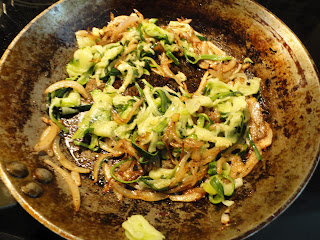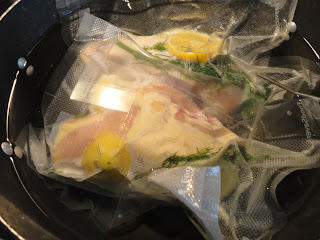I've been absent for several months, with really no good reason other than my own selfish ennui. J developed some stomach issues, and with that came cooking complication. All of the sudden onions, garlic, tomatoes, peppers, alcohol, vinegar, beans, and pretty much anything spicy came off the shopping list. I was flummoxed, and instead of rising to the occasion, I subjected both of our palates all summer long to plain grilled meats, fish, and veggies. Plain rice and potatoes dominated the starch category. No squeeze of lemon or fresh garden tomatoes welcome. I met a new challenge and I folded. I'm ashamed.
That said, with some diligence and a bit of medical science he is on the road back to being able to eat a wider variety of foods, with just a few adjustments. I've discovered that many of the verboten ingredients lose some of their ferocious kick with long simmering and a judicious hand. "Hot" is still out, but I have found ways to spice things up on my own food without assaulting J's stomach and his peace of mind. My first leap into the abyss started with a wonderful vegetarian lasagna featuring tomatoes, eggplants and herbs from the late summer garden. I had to buy zucchinis and squash. As quickly as our crop came, it disappeared.
zucs, squash, and mushrooms get diced for the filling--
in the small bowl are some diced eggplants, salted to remove moisture
I constructed the sauce from garden tomatoes, simmered whole to remove moisture and loosen the skins, then passed through the coarse disc on a food mill, to eliminate seeds, skins, and cores. A food mill is an inexpensive and handy tool to have when you want to separate out the bad stuff and keep the good stuff.
with a food mill, the pulp and juice pass through the holes,
while the seeds, skins, and stems stay behind
The sauce is lightly cooked tomatoes, salt, garlic, a bit of
red pepper flake, and fresh basil
To mellow the garlic even more than it would during baking, I have used the trick of microwaving a few cloves on high for 15 seconds. The resulting steam partially cooks the garlic, and as a bonus, makes the skins slip right off. I limited the red pepper flakes to just a couple of pinches--very little in the overall scheme of ingredients.
While the sauce flavors melded, I squeezed the eggplant dry, and very gently sauteed all of the veggies in a splash of olive oil. The idea is not to brown the veggies, but to significantly reduce their moisture. Ordinarily I would have added a chopped onion and bell pepper as well to this mixture, and I suggest you do. I just didn't want to push things too far on this first foray into the forbidden foods.
the idea here is a significant reduction of the moisture in the veggies
once the veggies were done, I wilted a bag of baby spinach, cooked with
a tablespoon or so of dried shallots--for some onion flavor without
the volatile compounds
Once the spinach is wilted, wrap it in a kitchen towel and wring the bejeezus out of it, to remove as much moisture as possible. Vegetable liquids in a lasagna = watery, unappetizing fare.
veggies are combined and allowed to cool for assembly
I have read in Cooks Illustrated on several occasions that cottage cheese is superior to ricotta in lasagna--it doesn't become grainy, adds a bit of tang, and adds some welcome creaminess. All right, I'll bite. I gave it a shot. Whole milk or 2% cottage cheese combined with a cup of cream, and a cup of shredded parmesan. An added teaspoon of corn starch will help everything stay thick in the final dish. I added some lemon zest for brightness without acid, and a grating of nutmeg for some warmth. Then I grated some mozzarella and prepared for assembly.
the addition of cornstarch to the cottage cheese mixture
ramps up the creamy texture
I strongly recommend grating your own mozzarella. The pre-shredded stuff is treated to prevent clumping, which will also affect the gooey quality of the cheese in the baked dish. Squeeze the balls of mozzeralla--the softer they feel, the less rubbery the cheese will be. I tend to prefer Polly-O cheese, found usually near the shredded cheeses, though I have found that cheese quality varies by brand through different regions. Partially freezing the cheese before grating makes grating easier.
assembly--sauce, Barilla no-boil lasagna noodles, veggies, mozzarella,
and cottage cheese
I really love Barilla no-boil lasagna noodles. They are hassle-free, come out very similar to home-made noodles, and absorb any excess moisture in the lasagna. Start with a third of the sauce in a pan coated with non-stick spray. Add a layer of noodles, half of the veg, a generous sprinkle of mozzarella, and half the cottage cheese mixture. Repeat. Finish with a layer of noodles, the remaining sauce, and a layer of mozzarella.
I made two--a small one for our dinner, and a larger one
for the freezer, and a later informal dinner with friends
Cover both pans with foil sprayed with non-stick spray, and pop one in the freezer wrapped in a layer of plastic wrap, if you are making two, which is a great idea for an easy meal down the road. The one you are eating now can go into a 375 oven for about 40 minutes, or until bubbly. Remove the foil, and bake for another 15 minutes, or until the cheese begins to turn golden.
a fifteen minute rest, and it is ready to serve with a little garlic toast
and a sprinkling of fresh basil
I love this dish for several reasons. It is loaded with vegetables, delicious to eat, pretty to look at, and satisfyingly simple. I also love that it can be made ahead, and popped in the fridge or freezer for later baking.
I can clean up the kitchen before dinner, which means relaxing after dinner, and it is hearty enough vegetarian fare for even the most carnivorous of diners.

























































